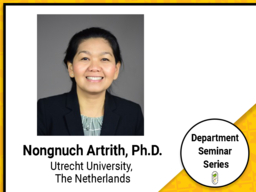Department Seminar Series - Dr. N. Artrith
Modelling of Complex Energy Materials with Machine Learning
Location
Online
Department Seminar Series - Dr. N. Artrith – Online Event
Date & Time
October 15, 2021, 2:00 pm – 3:00 pm
Description
Modelling of Complex Energy Materials with Machine Learning
Nongnuch Artrith
Materials Chemistry and Catalysis, Debye Institute for Nanomaterials Science,
Utrecht University, The Netherlands
E-mail: n.artrith@uu.nl
Biography:
Nong Artrith is a Tenure-Track Assistant Professor in the Materials Chemistry and Catalysis Group at the Debye Institute for Nanomaterials Science. Prior to joining Utrecht University, Nong was a Research Scientist at Columbia University, USA, and a PI in the Columbia Center for Computational Electrochemistry. Nong obtained her PhD in Theoretical Chemistry from Ruhr University Bochum, Germany, for the development of machine-learning (ML) models for materials chemistry. She was awarded a Schlumberger Foundation fellowship for postdoctoral research at MIT and subsequently joined UC Berkeley as an associate specialist. In 2019, Nong was named a Scialog Fellow for Advanced Energy Storage. She is the main developer of the open-source ML package ænet (http://ann.atomistic.net) for atomistic simulations. Her research interests focus on the development and application of first principles and ML methods for the computational discovery of energy materials and for the interpretation of experimental observations.
Keywords:
DFT, Machine Learning, Artificial Neural Networks, Energy Materials
Abstract:
The properties of materials for energy applications, such as heterogeneous catalysts and battery materials, often depend on complicated chemical compositions and complex structural features including defects and disorder. This complexity makes the direct modelling with first principles methods challenging. Machine-learning (ML) potentials trained on first principles reference data enable linear-scaling atomistic simulations with an accuracy that is close to the reference method at a fraction of the computational cost. ML models can also be trained to predict the outcome of simulations or experiments, bypassing explicit atomistic modelling altogether.
Here, I will give an overview of our contributions to the development of ML potentials based on artificial neural networks (ANNs) [1-3] and applications of the method to challenging materials classes including metal and oxide nanoparticles, amorphous phases, and interfaces [4-5]. Further, I will show how large computational and small experimental data sets can be integrated for the ML-guided discovery of catalyst materials [6]. These examples show that the combination of first-principles calculations and ML models is a useful tool for the modelling of nanomaterials and for materials discovery. All data and models are made publicly available. To promote Open Science, we also formulated guidelines for the publication of ML models for chemistry that aim at transparency and reproducibility [7].
References
- N. Artrith and A. Urban, Comput. Mater. Sci., 2016, 114, 135.
- N. Artrith, A. Urban, and G. Ceder, Phys. Rev. B, 2017, 96, 014112.
- A. Cooper, J. Kästner, A. Urban, and N. Artrith, npj Comput. Mater., 2020, 6, 54.
- N. Artrith and A.M. Kolpak, Nano Lett., 2014, 14 2670.
- N. Artrith, J. Phys. Energy, 2019, 1, 032002.
- N. Artrith, Z. Lin, and J. G. Chen, ACS Catal., 2020, 10, 9438; N. Artrith, Matter 3 (2020) 985–986.
7. N. Artrith, K. Butler, F.X. Coudert, S. Han, O. Isayev, A. Jain, and A. Walsh, Nat. Chem. 13 (2021) 505–508.
